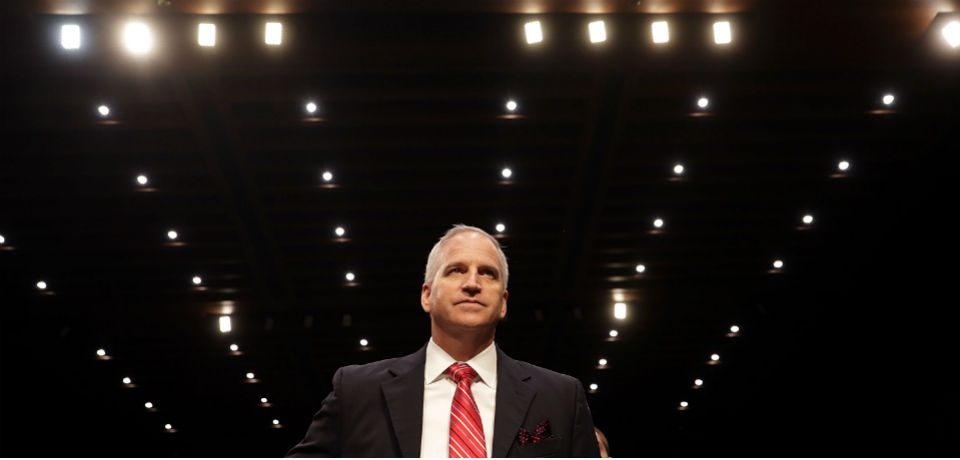If Robert Cardillo has his way, robots will perform 75 percent of the tasks currently done by American intelligence analysts who collect, analyze, and interpret images beamed from drones, satellites, and other feeds around the globe.
read more – copyright by fp-reg.onecount.net
 Cardillo, the director of the National Geospatial-Intelligence Agency, known by the acronym NGA, announced his push toward “automation” and artificial intelligence at a conference this week in San Antonio. The annual conference, hosted by the United States Geospatial Intelligence Foundation, brings together technologists, soldiers, and intelligence professionals to discuss national security threats, changes in technology, and data collection and processing.
Cardillo, the director of the National Geospatial-Intelligence Agency, known by the acronym NGA, announced his push toward “automation” and artificial intelligence at a conference this week in San Antonio. The annual conference, hosted by the United States Geospatial Intelligence Foundation, brings together technologists, soldiers, and intelligence professionals to discuss national security threats, changes in technology, and data collection and processing.
Artificial Intelligence is everywhere
Artificial intelligence is on the rise; former President Barack Obama’s White House released a white paper on its potential future impacts in the final months of the administration. Police officers are using preliminary programs to predict the likelihood someone will commit a crime in a specific neighborhood based on crime statistics data. And companies like Amazon and Netflix use machine learning to calculate what movie you will want to watch or which book you may buy.Yet this sort of automation is also seen as a threat to workers, who fear being put out of jobs, particularly in the private sector.The fear that artificial intelligence will take over jobs, or fail catastrophically along the way, is palpable in the intelligence community as well, and Cardillo admitted that the workforce is “skeptical,” if not “cynical” or “downright mad,” about the prospect of automation intruding on their day-to-day lives, potentially replacing them.
Transforming Opportunity
Cardillo, who called it a “transforming opportunity for the profession,” said he’s working on showing the workforce that artificial intelligence is “not all smoke and mirrors.” The message he’s sending to workers at the agency is that the goal of automation “isn’t to get rid of you — it’s there to elevate you.… It’s about giving you a higher-level role to do the harder things.” In Cardillo’s eyes, the profession of geospatial intelligence — monitoring and exploiting commercial and proprietary video and imagery feeds around the world — is on the precipice of a data explosion similar to when the internet took off. At that point, the National Security Agency, which is responsible for collecting and analyzing digital communications, had to figure out ways to vacuum up and glean specific conclusions from an explosion of communications traveling back and forth on the web. […]
read more – copyright by foreignpolicy.com


If Robert Cardillo has his way, robots will perform 75 percent of the tasks currently done by American intelligence analysts who collect, analyze, and interpret images beamed from drones, satellites, and other feeds around the globe.
read more – copyright by fp-reg.onecount.net
Artificial Intelligence is everywhere
Artificial intelligence is on the rise; former President Barack Obama’s White House released a white paper on its potential future impacts in the final months of the administration. Police officers are using preliminary programs to predict the likelihood someone will commit a crime in a specific neighborhood based on crime statistics data. And companies like Amazon and Netflix use machine learning to calculate what movie you will want to watch or which book you may buy.Yet this sort of automation is also seen as a threat to workers, who fear being put out of jobs, particularly in the private sector.The fear that artificial intelligence will take over jobs, or fail catastrophically along the way, is palpable in the intelligence community as well, and Cardillo admitted that the workforce is “skeptical,” if not “cynical” or “downright mad,” about the prospect of automation intruding on their day-to-day lives, potentially replacing them.
Transforming Opportunity
Cardillo, who called it a “transforming opportunity for the profession,” said he’s working on showing the workforce that artificial intelligence is “not all smoke and mirrors.” The message he’s sending to workers at the agency is that the goal of automation “isn’t to get rid of you — it’s there to elevate you.… It’s about giving you a higher-level role to do the harder things.” In Cardillo’s eyes, the profession of geospatial intelligence — monitoring and exploiting commercial and proprietary video and imagery feeds around the world — is on the precipice of a data explosion similar to when the internet took off. At that point, the National Security Agency, which is responsible for collecting and analyzing digital communications, had to figure out ways to vacuum up and glean specific conclusions from an explosion of communications traveling back and forth on the web. […]
read more – copyright by foreignpolicy.com
Share this: